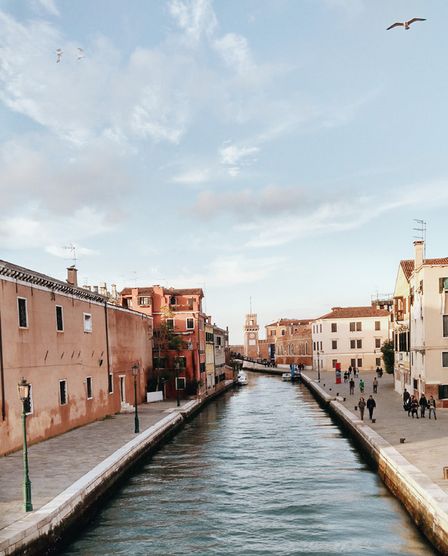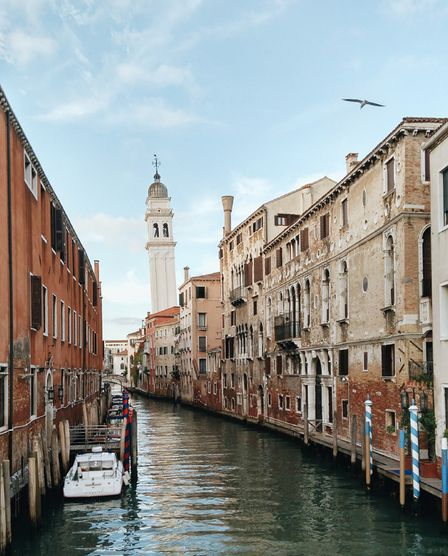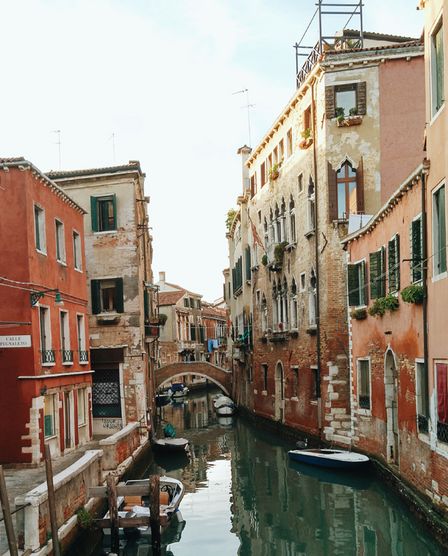What is Slow Travel?
Aug 15, 2018
By Dee Agniezska, Owner | Vanilla Papers, Egypt | www.vanillapapers.net
I’m having a dirty martini at 1897 bar, a darkened lounge in New Cairo filled with leather couches and rugs, when a friend asks about my trip to Italy. I’ve just returned to Egypt after four days in Venice and my memories of the floating city are fresh enough to light up my face.
“It was fantastic,” I say.
I remember waking up every morning at a woody campsite just outside Venice, then taking a bus into the city and wandering for hours. Meandering down side streets where locals walk their dogs and chat from balconies, having no idea where I was on the map.
Streets end in sprawling piazzas or watery dead ends. One leads to the edge of the city where the houses are poorer and less ornate, and where I get sprawling views of the Adriatic.
The wandering feels like a waltz with the city as my partner. I whirled in circles taking pleasure in a dance that’s ultimately directionless.
“You went to Venice, right?” my friend asks. “Where else did you go?”
“Just Venice,” I say. “I stayed there the whole time.”
“You didn’t go to Florence or Rome?” she asks. “I love Rome. And the food is the best!”
I feel a tinge of regret and wonder if I’d done the right thing. The trip into Venice on my first day had been exhausting. I missed my train, ran out of change to buy another ticket, and got soaked in the rain. Had I just been too tired at that point for a jaunt across Italy? Was I getting old?
But Venice was so gorgeous! I wandered its side streets until it was time to catch the last bus back to the campsite, and vowed I’d return and stay longer.
And I had been to Florence and Rome. After graduation, in a rush to grow up and be cosmopolitan, I’d taken a few whirlwind guided tours and checked Italy and Paris off my bucket list. I’d raced from one attraction to another, getting on and off our bus, in a haze I now remember only from photos.
And what had been the point? I’ve technically seen Paris and Rome, but had the experience changed me? Did I get anything out of it, besides bragging rights and a few photos?
In a culture where a good education means a well-paying job, and where money means comfort and security, travel can become just another commodity that’s held up as a status symbol. The Apple icon on the back of a golden phone, or the snapshot on Instagram from the trendiest summer vacation spot, are meant to tell others we’re living our best lives. Happy, fulfilled and successful.
Slow travel, as I’ve come to love it, is as much a backlash against this kind of materialism as it is a slower pace and less hectic itinerary.
The term “slow travel” may conjure up images of quiet alleys in rural France, with long lunches of organic cheeses, or months spent living in Bangkok steeped in the local culture. And it’s definitely about those kinds of immersive experiences.
But for me slow travel is a state of mind and an approach you take – whether you’re spending a single weekend in Paris or an entire summer in Provence.
Here’s how I see it:
Slow travel means knowing where you’re going.
The more you know about a country’s history, culture and customs, the more meaningful your trip will be. This can mean learning a few phrases of the language to communicate with locals, and reading up on the sites and local life you’re likely to encounter. Preparing and doing research also dulls culture shock and lets you integrate easier into your surroundings.
Before you arrive, reading novels by local authors or watching local films can get you excited for the trip, and make the places more significant when you arrive.
 Slow travel means quality over quantity.
Slow travel means quality over quantity.

To really get to know a destination, you have to give yourself time to wander and explore. Leave room for the spontaneous and keep your itinerary flexible. Get to know a city beyond its tourist attractions.
Walking is often the best way to discover a new place. The surprises along the way can turn vacations into adventures and meaningful journeys, while the slower pace allows you to be more mindful of your surroundings and notice things you’d miss from a speeding bus window.
It’s about knowing yourself and following your bliss.
Slow travel isn’t about skipping the major tourist attractions and spending your days wandering down quiet side streets. The iconic landmarks are famous for a reason and are often worth visiting. A bit of research can reveal which spots are overrated, however, and which are hidden gems.
Slow travel means being more selective and maximizing your time. It’s about following your gut and forgetting other people’s “must see” lists – and writing your own.
It’s knowing yourself and being honest about what you love. If you’re a big Oscar Wilde fan, and there’s an exhibit of his works in Paris, then it means heading there and skipping the Louvre if you’re not that excited about it.
Author Joshua Becker once said: “Minimalism is the intentional promotion of the things we most value and the removal of anything that distracts us from it.”
Likewise, slow travel isn’t about missing out on anything because you’re going at a slower pace. It’s about focusing on the things you’re excited about and skipping anything that feels like an obligation.
 It means getting a taste of local, everyday life.
It means getting a taste of local, everyday life.

Immersing yourself in the local life is the best way to understand a new culture. This can mean staying at an Airbnb on a residential street, eating at a restaurant that doesn’t cater to tourists, or taking a walk through a local park.
Asking locals for recommendations is a great way to discover authentic food and hidden gems that are off the beaten tourist path.
Getting involved in the local communities you’re visiting can be a great way to quickly integrate yourself in a foreign city. Sign up for a cooking class, volunteer, take a walking tour or spend an evening at a local concert or theater.
Being responsible, and protecting the environment.
Slow travel is as an offshoot of the slow food movement, which began in Italy in 1986 to resist the opening of a McDonald’s near the Spanish Steps in Rome. The slow food movement emphasizes local food and traditional cooking over mass-produced, homogeneous fast food.
And in the same way, slow travel emphasizes a visitor’s connection to local communities over mass tourism and one-size-fits-all itineraries.
For me, this also means supporting local artisans and traditional handcrafts, as well as supporting local businesses whenever possible. Cheap, mass-produced mementos that are made in China have put too many skilled craftsman out of business.
It means staying at eco-friendly hotels, not littering, buying fair trade whenever possible, and not taking part in any activities that exploit people, animals or the environment.

Enjoying the ride.
The process of getting from point A to point B can be just as enjoyable as the destination. Slow travel can mean (but doesn’t have to) travel by boat, bike or train, or anything that lets you take in your surroundings.
Road trips are perfect examples of slow travel because they’re all about the experiences along the way.
And while slow travel isn’t for everyone, for me it’s the best way to understand a culture, relax, enjoy a place and explore deeper.
View Dee's own travel blog here .
Follow us on social media via the links below and discover all of our Travelations here .
If you would like to speak to one of Tribe's travel experts, or would like to view our travel/tourism credentials, please email Elaine here .
Tribe Global is a network of over 30 independent agencies and business Partners working together with an overwhelming passion for solving client challenges creatively, with a commercial imperative. Travelations are for travel marketers seeking global perspective, actionable insights and business advantage. For more Travelations and examples of our deep Tribal travel/tourism experience, find us at tribeglobal.net.







